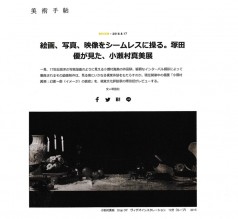
BIJUTSU-TECHO
Web Magazine
BIJUTSU SHUPPAN-SHA CO., LTD.
Bijutsu-Techo (Web)
August 17, 2018 Issue
August 17, 2018
Manipulating the boundaries between painting, photography and video: Yutaka Tsukada on the exhibition of Mami Kosemura
Publisher: BIJUTSU SHUPPAN-SHA CO., LTD. / Writer: Yutaka Tsukada (Visual Culture Critic)
*日本語website記事はこちら(https://bijutsutecho.com/magazine/review/18240)
___________
At first glance, the works of Mami Kosemura resemble the style of 17th century Western realism paintings. Upon closer inspection, they are actually animated still-lifes which are created by taking consecutive pictures at fixed time intervals. What kind of visual experience do her works bring to the viewers? A visual culture critic, Yutaka Tsukada discusses her current solo exhibition “Phantasies Over Time”.
According to Andrei Tarkovsky’s “Sculpting in Time (1988)”, the tempo of editing in films “emerges organically in response to the director's intrinsic sense of life and through his commitment to the 'quest for time’”.
What makes this ‘quest for time’ possible for Mami Kosemura is the production of animation. Canadian animator Norman McLaren describes its inherent nature as ‘art that manipulates the invisible gaps between the frames’ in his article “The Definition of Animation : A Letter from Norman McLaren, with an Introduction by Georges Sifianos (Hyosho 7th issue, 2013)“ Let’s take a look at Kosemura’s “Sweet Scent (2003)” as an example.
First, Kosemura set up a digital SLR camera on a surface which captured images over several months at fixed time intervals. By combining thousands of those images, she created the animation. The reason why the organic matter decays at such an unbelievably fast pace is that the time intervals were controlled by Kosemura, faithfully adhering to McLaren’s definition of animation.
However, we can see a turning point which breaks down the categorization in her “Episode III (2002)”. It is also an animation work in which she combines time-lapse images of flowers and a person (Kosemura herself). What I would like to examine here is the moment when the flower begins to decay and the sleeping woman's clothes become dirty. The changes in the images have a psychological effect on the viewer, bringing him or her back to the moment of the initial feeling of life. This image that Kosemura’s work ignites in the viewer is also known as “punctum”. It’s said that punctum can occur in memory as well, and it transforms a photograph that should have been a ‘moment’ into a ‘memento’. This allows indexed photographic images to be trapped within a strong temporal gap.
The medium goes from animation to photography and back even further to painting. Kosemura’s “Episode III” asks us to question the boundary between life and death and encompasses the theme of martyrdom in the history of Western paintings while paying homage to the world's first portrait “Self Portrait as a Drowned Man (1840)” by Hippolyte Bayard's in which he pretended to be ‘dead’. Bayard’s portrait also has some similarities to Jacques-Louis David’s painting “The Death of Mara (1793)”.
In this way, Kosemura has been exploring the layers of media in painting, photography and animation since the beginning of her career. In her recent works, we can see her challenging this structural approach in a straightforward way, rather than appropriating art history.
In "Pendulum (2016)”, Kosemura, who has paradoxically accentuated the violence of the camera by contrasting it with organic objects, sees the camera in the motion of a pendulum, making the device operate as an autonomous system distinct from human vision. The manipulation between frames in this film has an irregular slowness, while at the same time muddling the tenses through the various shifts in the images. The transparency of the mirror-like screen leaps to transcendence, and viewers will be under the illusion that the mirrored surface is a pathway to another world, just like Alice, and will dream of being easily transplanted.
Such a timeless suspension is also seen in "Drop Off (2015)”, which revolves around the sense of anticipation by stretching out four seconds of movement to 12 minutes.
Kosemura's work, which erases history and invites cross-referencing between mediums by eliminating allusions, exposes the inherent fictionality of the image. In his book, “Le Banquet des Anges (1988)”, Dominick Fernandez describes the sculpture of a veiled woman at the Wulzburg Residence, a typical Baroque palace, as follows:
“The Baroque artists deny our internal unity. They judge our existence as diverse, inconstant and constantly changeable. Therefore, they think that we, hidden behind veils and masks, are what we are most of all.”
The exhibition includes a series of photographs entitled "Veil" (2011). Her commentary, that accompanies them, seems to echo Fernandez's insight. Kosemura says that in the veiled scene, she feels ‘a void of empty time between the end of things and the beginning of things’. When something is covered, its "The Epidermis of Images" condenses ambiguity. In her early work “The Rose”, she worked on the appropriation of Zurbarán, one of the leading still-life painters of the Baroque period, and at the end of her exploration of the mediums of painting, photography and video, she finally found the source of her aesthetic.
___________
*Translators of this article
Yuki Matsumura, Masha Bogushevsky (https://www.befluentnyc.com)